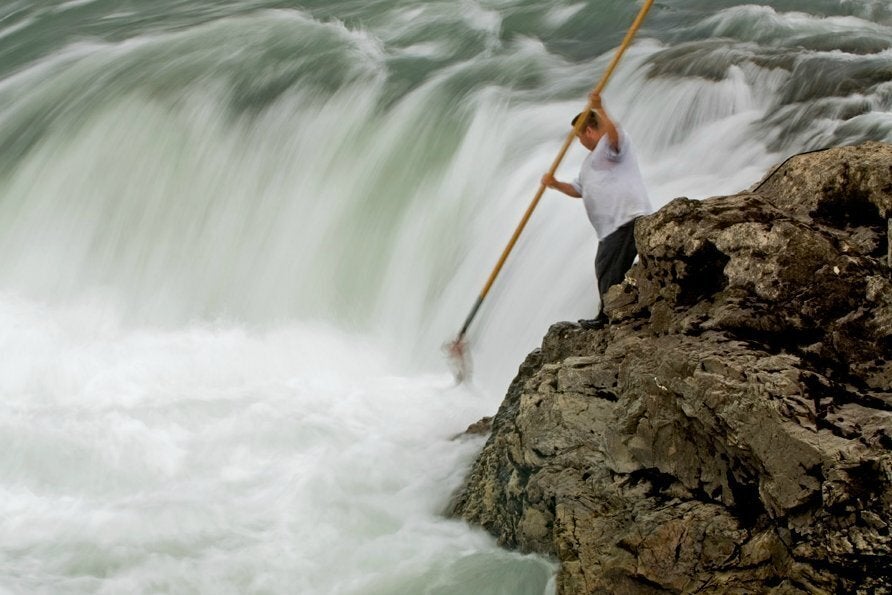This is not a story of Tibet or the Amazon, of life on the Arctic ice or in the searing sands of the Sahara. It is a story of my own backyard, a land known to the Tahltan people and all the First Nations of British Columbia as the Sacred Headwaters, the birthplace of the three great free flowing salmon rivers of home, the Stikine, Skeena and Nass.
It is a high broad valley, nestled among mountains that score every horizon. In a long day, perhaps two, you can follow the tracks of grizzly and wolf, caribou and moose, and drink from the very sources of the rivers that cradled the great civilization of the Pacific Northwest.
When in 1879 John Muir experienced but the lower third of the Stikine he called it a Yosemite a hundred miles long, and he later named his beloved dog after this river of his enchantment. The Grand Canyon of the Stikine, Canada's greatest canyon, often described as the K2 of whitewater challenges, was not successfully run by kayak until 1985; since then fewer than 50 men and women, all world-class athletes, have made it through. No raft has ever done so.
In the lower 48 the farthest you can get away from a maintained road is 20 miles (32 km); in this northwest quadrant of British Columbia, an area the size of Oregon, there is one road, a narrow ribbon of tarmac heading north to the Yukon along the flank of the Coast Mountains.
I followed this road north in the 1970s, soon after it was built, to take a job as the first park ranger in the Spatsizi, the Serengeti of Canada. The job description was deliciously vague, wilderness assessment and public relations. In two four-month seasons I encountered but a dozen people.
In the course of my wanderings I came upon a shaman's grave, which led to an encounter with remarkable man, a Gitxsan elder who had lived all his life in the bush as a hunter and trapper. For more than 30 years I recorded stories from Alex, the myths of Wy-ghet, the trickster transformer of Gitxsan lore, who in his folly taught the people the proper way to live on the land. These were all whimsical tales of moral gratitude played out against and within the backdrop of nature.
Story continues after slideshow
Through time, isolation has been the country's saving grace; now this very isolation could be its doom. The tar sands, Enbridge and Keystone pipelines -- these are just elements of a tsunami of industrial development sweeping over the Canadian north. In Tahltan territory alone there are 41 major projects, some with considerable promise, some of great concern.
On Todagin Mountain, a wildlife sanctuary in the sky, revered by the Tahltan as the home of the largest population of Stone sheep in the world, Imperial Metals intends to build a massive open pit copper and gold mine processing 30,000 tons of rock a day for 30 years. The project design calls for hundreds of millions of tons of toxic tailings to be dumped into the lakes of the headwaters, poisoning the source of the Iskut, the main tributary of the Stikine.
In the very meadows of the Sacred Headwaters, Shell seeks to extract methane gas by fracking coal seams that underlie a million acre tenure, drilling as many as 6,000 wells and injecting into the ground millions of gallons of toxic chemicals. The result would be a network of roads, pipelines, and flaring wellheads all producing gas to be shipped east to fuel the expansion of the tar sands.
Fortune Minerals would tear into the headwater valley itself, on a massive scale, with open pit anthracite coal operations that would level entire mountains.
HOME AND SANCTUARY
For more than a decade the Tahltan clans, Wolf and Crow, have actively opposed these assaults on their land, rivers and lakes. Men, women and children, old and young, even elders in wheelchairs have stood in rain and snow, blockading the only road access to the interior. For them the Sacred Headwaters is home, their kitchen and sanctuary, the burial grounds of their ancestors and the nursery of generations as yet unborn.
With the support of every municipality downstream, of every locally elected politician in every party, the Tahltan to date have blunted these efforts to violate their homeland. But now everything hangs in the balance. The fate of the country will be decided in the coming year.
Just before my old friend Alex died at 96, he gave me a gift, a tool carved by his grandfather from caribou bone in 1910, when Alex was a boy. It was a specialized tool, used by a trapper to skin out the eyelids of wolves. It was only after Alex passed away that I realized that the eyelids in question were my own and that Alex, having done so much to allow me to see, was in his own way saying goodbye.
Now surely he is calling out for all of us to open our eyes to what is happening in the north. The Tahltan have called for the creation of a Tribal Heritage Reserve that will protect the Sacred Headwaters, and in doing so create the greatest protected area in British Columbia, a vast and pristine wilderness that will reach all the way to the protected areas of Alaska.
The voices of all people deserve to be heard. Surely no amount of methane gas, coal, copper or gold can compensate for the sacrifice of a place that can be the Sacred Headwaters for all citizens of the world.
